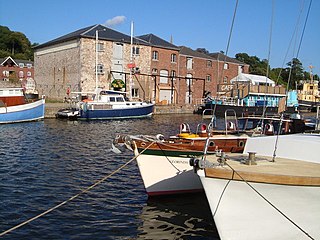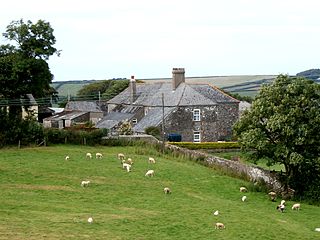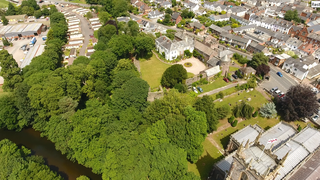Related Research Articles

Moretonhampstead is a market town, parish and ancient manor in Devon, situated on the north-eastern edge of Dartmoor, within the Dartmoor National Park. The parish now includes the hamlet of Doccombe, and it is surrounded clockwise from the north by the parishes of Drewsteignton, Dunsford, Bridford, Bovey Tracey, Lustleigh, North Bovey and Chagford.

Earl of Devon is a title that has been created several times in the Peerage of England. It was possessed first by the Redvers family, and later by the Courtenay family. It is not to be confused with the title of Earl of Devonshire, which is held by the Duke of Devonshire, although the letters patent for the creation of the latter peerages used the same Latin words, Comes Devon(iae). It was a re-invention, if not an actual continuation, of the pre-Conquest office of Ealdorman of Devon.

The Exeter Ship Canal, also known as the Exeter Canal is a canal leading from the River Exe to Exeter Quay in the city of Exeter, Devon, England. It was first constructed in the 1560s predating the "canal mania" period and is one of the oldest artificial waterways in the UK.

Powderham Castle is a fortified manor house situated within the parish and former manor of Powderham, within the former hundred of Exminster, Devon, about 6 miles (9.7 km) south of the city of Exeter and 1⁄4 mile (0.4 km) north-east of the village of Kenton, where the main public entrance gates are located. It is a Grade I listed building. The park and gardens are Grade II* listed in the National Register of Historic Parks and Gardens.
Boconnoc is a civil parish in Cornwall, England, United Kingdom, approximately four miles (6 km) east of the town of Lostwithiel. According to the 2011 census the parish had a population of 96.

Sir Hugh de Courtenay, 2nd/10th Earl of Devon, 2nd Baron Courtenay, feudal baron of Okehampton and feudal baron of Plympton, played an important role in the Hundred Years War in the service of King Edward III. His chief seats were Tiverton Castle and Okehampton Castle in Devon. The ordinal number given to the early Courtenay Earls of Devon depends on whether the earldom is deemed a new creation by the letters patent granted 22 February 1334/5 or whether it is deemed a restitution of the old dignity of the de Redvers family. Authorities differ in their opinions, and thus alternative ordinal numbers exist, given here.

Countess Wear is a district within the city of Exeter, Devon, England. It lies about two miles south-east of the city centre, on the north bank of the estuary of the River Exe. Historically an estate known as Weare, part of the manor of Topsham, was in this area. From the late 13th century, the construction of weirs in the River Exe by the Countess, and later, the Earls of Devon damaged the prosperity of Exeter to the benefit of Topsham which was downstream of the obstructions, and was owned by the Earls.

Halsbury is a historic manor in the parish of Parkham in North Devon, England. It is situated 2 miles north-east of the village of Parkham and 4 miles south-west of the town of Bideford. Halsbury was long a seat of the ancient Giffard family, a distant descendant of which was the celebrated lawyer Hardinge Stanley Giffard, 1st Earl of Halsbury (1823–1921), who adopted the name Halsbury for his earldom and was the author of the essential legal reference books Halsbury's Statutes. Halsbury Barton, now a farmhouse, retains 16th- and 17th-century elements of the former manor house of the Giffard family. It was described in a record of 1560 as a "new dwelling house".

Thomas de Courtenay, 5th/13th Earl of Devon was a nobleman from South West England. His seat was at Colcombe Castle near Colyton, and later at the principal historic family seat of Tiverton Castle, after his mother's death. The Courtenay family had historically been an important one in the region, and the dominant force in the counties of Devon and Cornwall. However, the rise in power and influence of several gentry families and other political players, in the years leading up to Thomas' accession to the earldom, threatened the traditional dominance of the earls of Devon in the area. Much of his life was spent in armed territorial struggle against his near-neighbour, Sir William Bonville of Shute, at a time when central control over the provinces was weak. This feud forms part of the breakdown in law and order in England that led to the Wars of the Roses.

Hugh de Courtenay, 1st/9th Earl of Devon of Tiverton Castle, Okehampton Castle, Plympton Castle and Colcombe Castle, all in Devon, feudal baron of Okehampton and feudal baron of Plympton, was an English nobleman. In 1335, forty-one years after the death of his second cousin once-removed Isabel de Redvers, suo jure 8th Countess of Devon he was officially declared Earl of Devon, although whether as a new creation or in succession to her is unknown, thus alternative ordinal numbers exist for this Courtenay earldom.
The Bonville–Courtenay feud of 1455 engendered a series of raids, sieges, and attacks between two major Devon families, the Courtenays and the Bonvilles, in south west England, in the mid-fifteenth century. One of many such aristocratic feuds of the time, it became entwined with national politics due to the political weight of the protagonists. The Courtenay earls of Devon were the traditional powerbrokers in the region, but by this time a local baronial family, the Bonvilles, had become more powerful and rivalled the Courtenays for royal patronage. Eventually this rivalry spilled over into physical violence, including social disorder, murder, and siege.
Sir Hugh de Courtenay (1251–1292) was the son and heir of John de Courtenay, feudal baron of Okehampton, Devon, by Isabel de Vere, daughter of Hugh de Vere, 4th Earl of Oxford. His son inherited the earldom of Devon.

Sir Philip Courtenay of Powderham, Devon, was the senior member of a junior branch of the powerful Courtenay family, Earls of Devon.

Thomas Courtenay, 6th/14th Earl of Devon, was the eldest son of Thomas de Courtenay, 5th/13th Earl of Devon, by his wife Margaret Beaufort, the daughter of John Beaufort, 1st Earl of Somerset, and Margaret Holland, daughter of Thomas Holland, 2nd Earl of Kent. Through his mother, he was a great-great-grandson of King Edward III. The ordinal number given to the early Courtenay Earls of Devon depends on whether the earldom is deemed a new creation by the letters patent granted 22 February 1334/5 or whether it is deemed a restitution of the old dignity of the de Redvers family. Authorities differ in their opinions, and thus alternative ordinal numbers exist, given here.

Tiverton Castle is the remains of a medieval castle dismantled after the Civil War and thereafter converted in the 17th century into a country house. It occupies a defensive position above the banks of the River Exe at Tiverton in Devon.

William de Botreaux (1337–1391) was a prominent British West-Country baron during the reigns of King Edward III (1327-1377) and King Richard II (1377-1399).

The Bohun swan, also known as the Bucks Swan, was a heraldic badge used originally in England by the mediaeval noble family of de Bohun, Earls of Hereford, and Earls of Essex.
The manor of Bideford in North Devon was held by the Grenville family between the 12th and 18th centuries. The full descent is as follows:

The Mayor of Exeter, granted Lord Mayor of Exeter in 2002, is the Mayor of Exeter in the ceremonial county of Devon, England and is elected by and from within the councillors of the City of Exeter council. The position is the third oldest mayoralty in the United Kingdom, behind the Lord Mayor of London and Mayor of Winchester, being founded in 1200.

John de Moels, 1st Baron Moels, feudal baron of North Cadbury in Somerset, was an English peer.
References
- 1 2 Wheaton, Kelly (2012-10-10). "Earliest Wheaton now the year 1288". Wheaton Wood.
- 1 2 3 Izacke, Richard (1677). Antiquities of the City of Exeter.
- 1 2 3 Jenkins, Alexander (1806). The history and description of the city of Exeter, and its environs. p. 56.
- ↑ "The Estuary of the River Exe". The Nautical Magazine and Naval Chronicle. Simpkin, Marshall and Co., London. 1847. pp. 197–198.
- ↑ Crossing, William (1911). Folk rhymes of Deon: notices of the metrical sayings found in the lore of the people. pp. 22–24.
- ↑ "MORE ON MAYOR Roger Bevyn Le Wheaton". Wheaton Wood.
- ↑ de la Garde, Philip Chilwell (1838). "On the Antiquity and Invention of the Lock Canal of Exeter". Archaeologia. 28 (1): 11. Retrieved 13 May 2017.